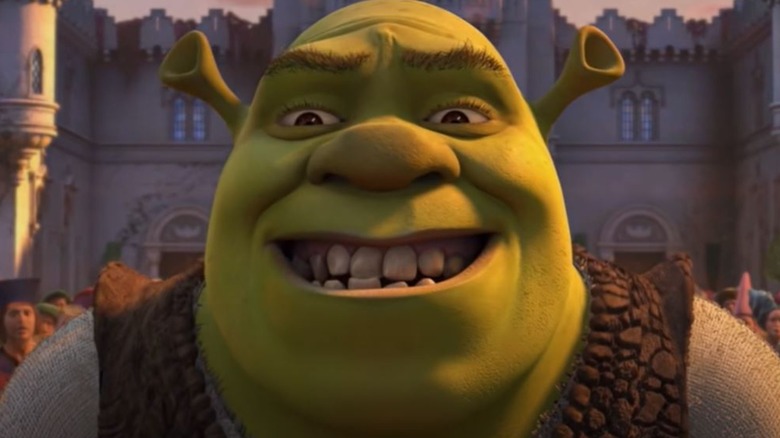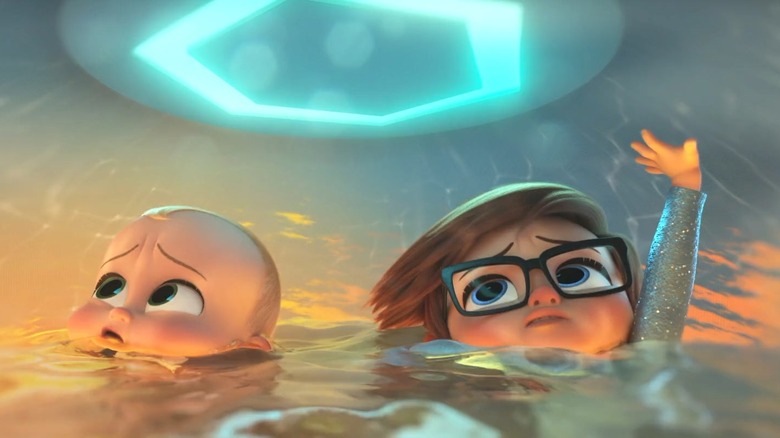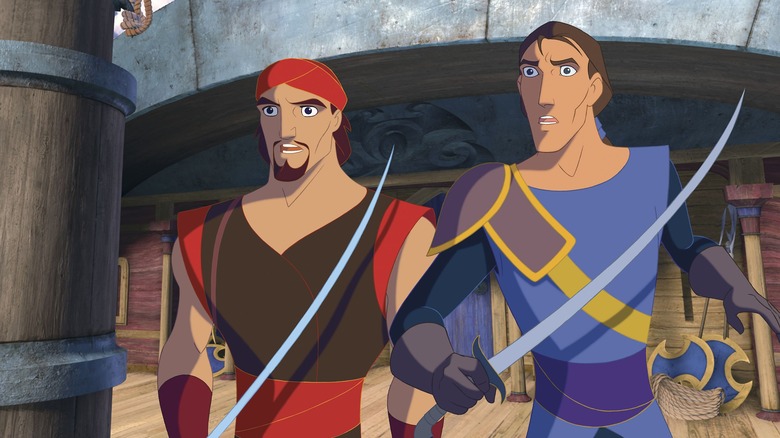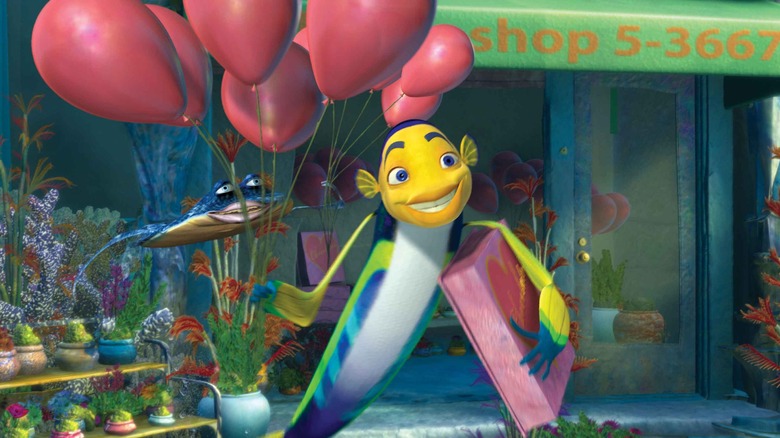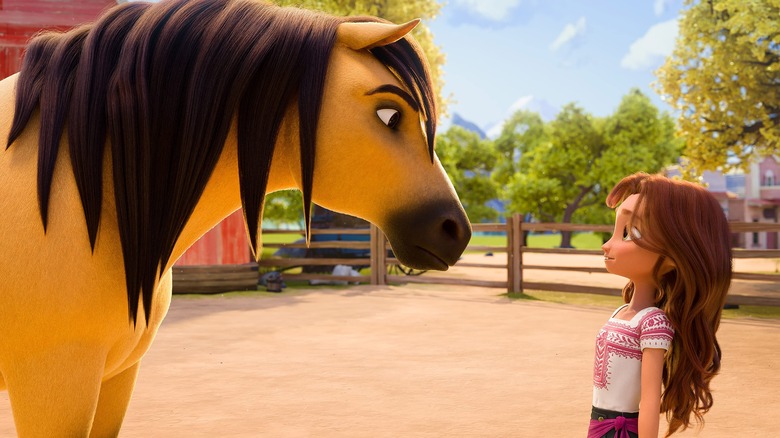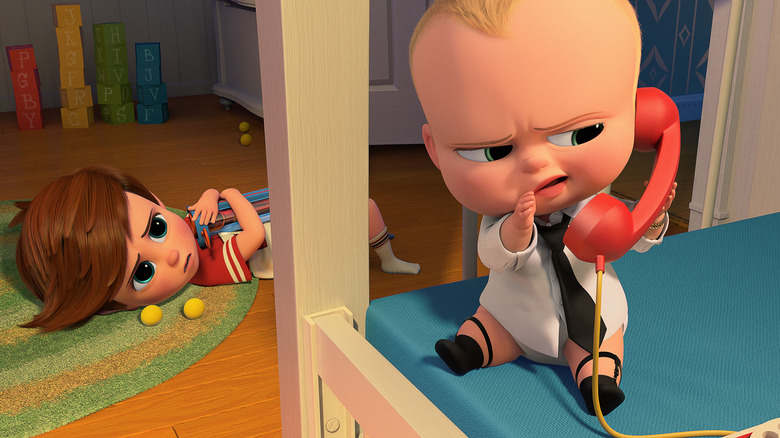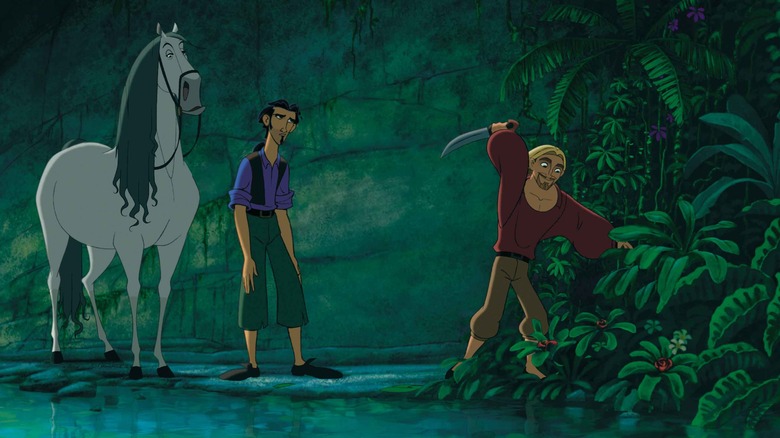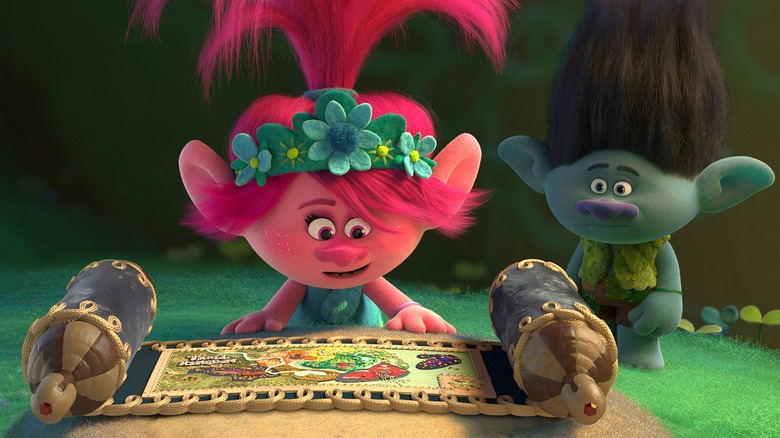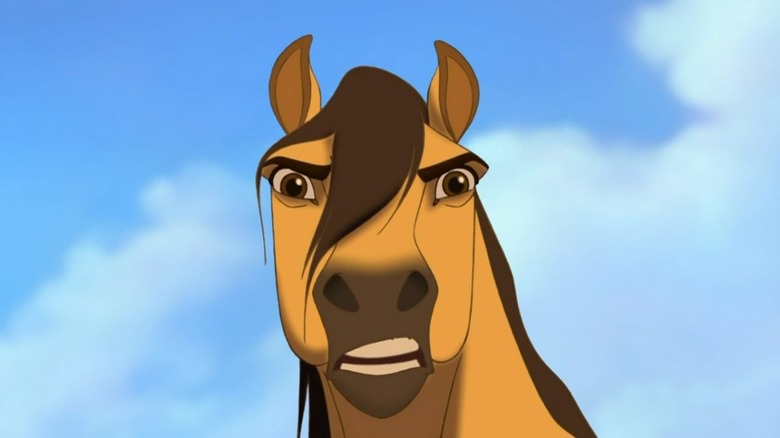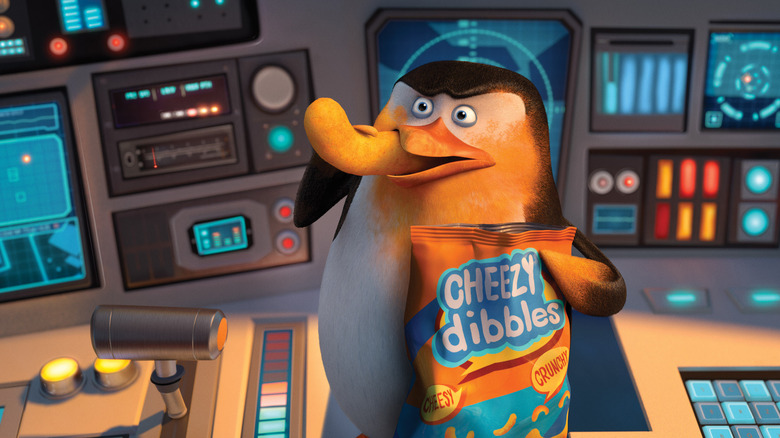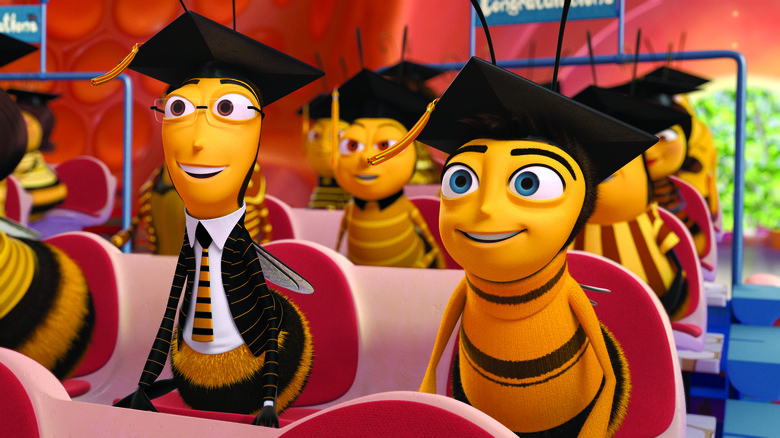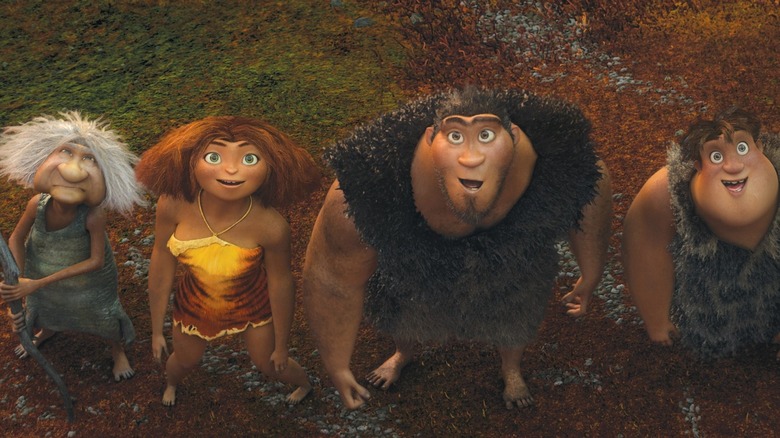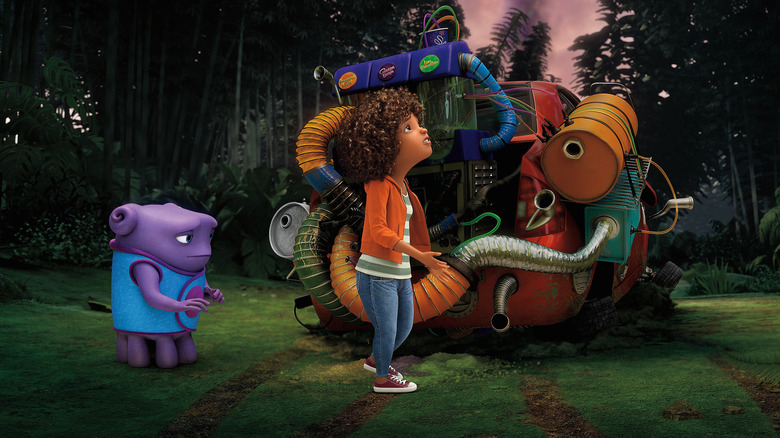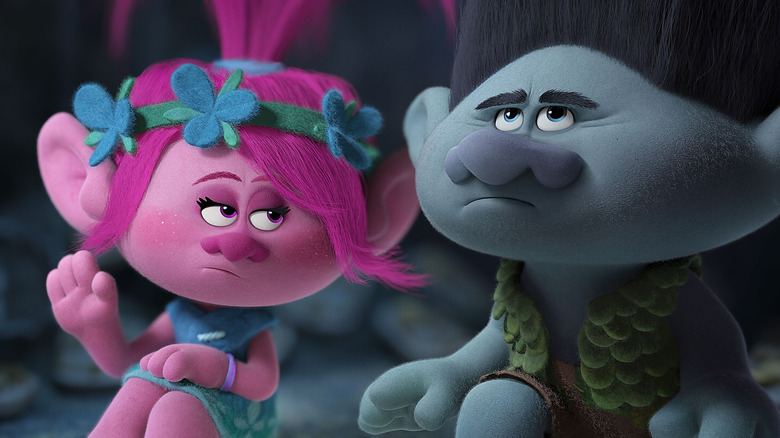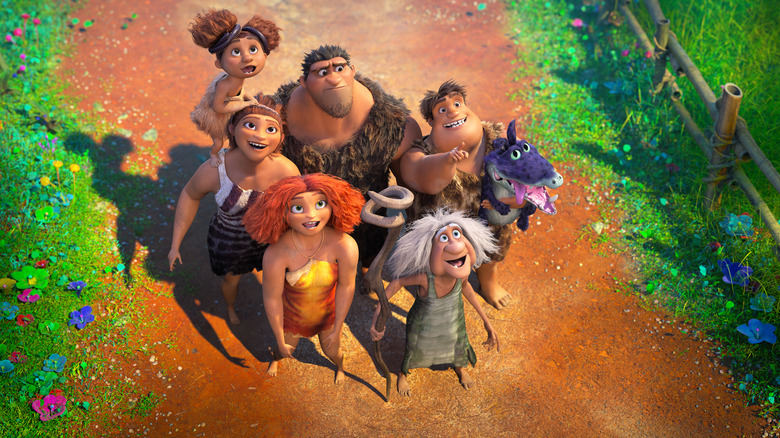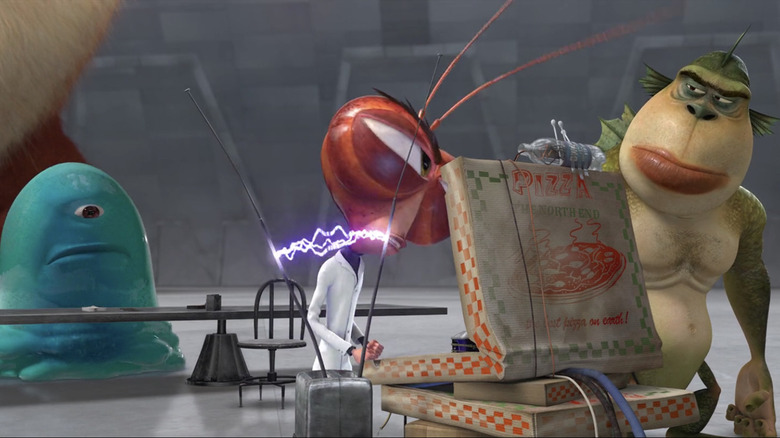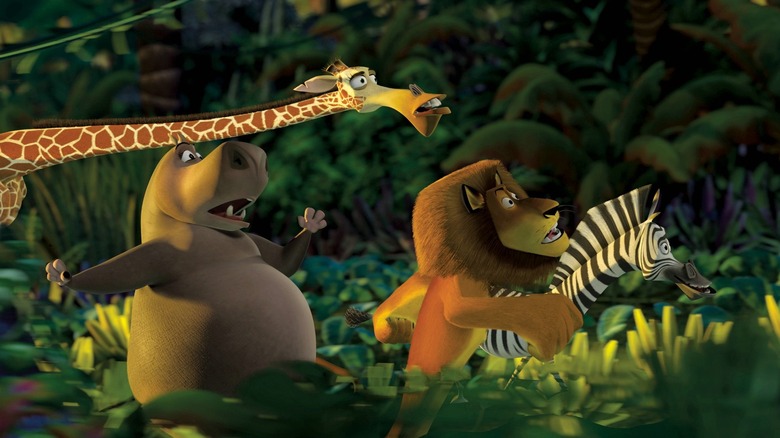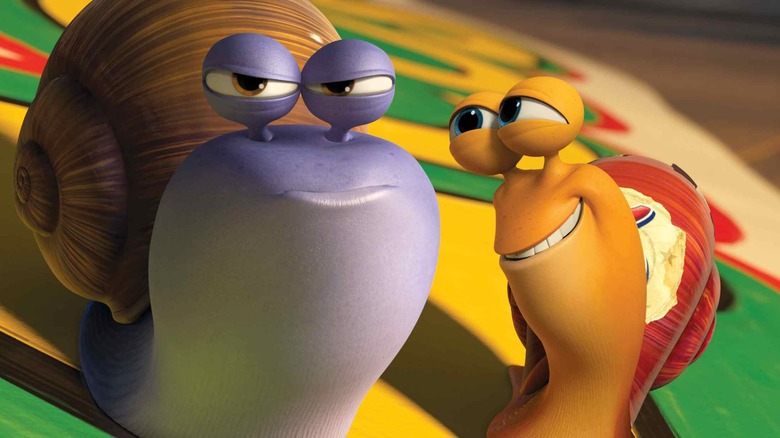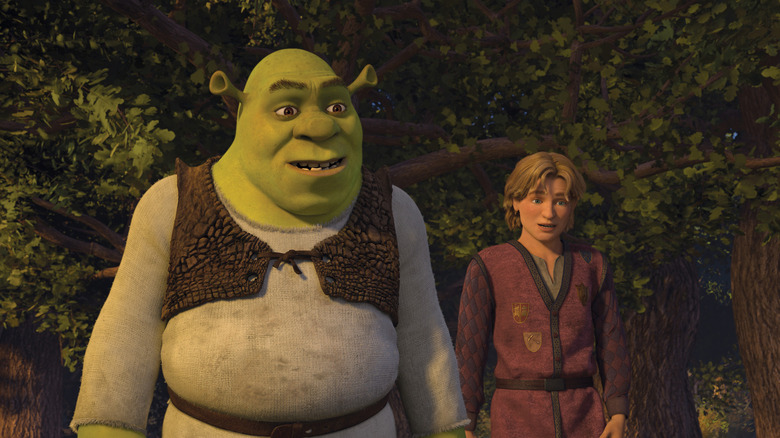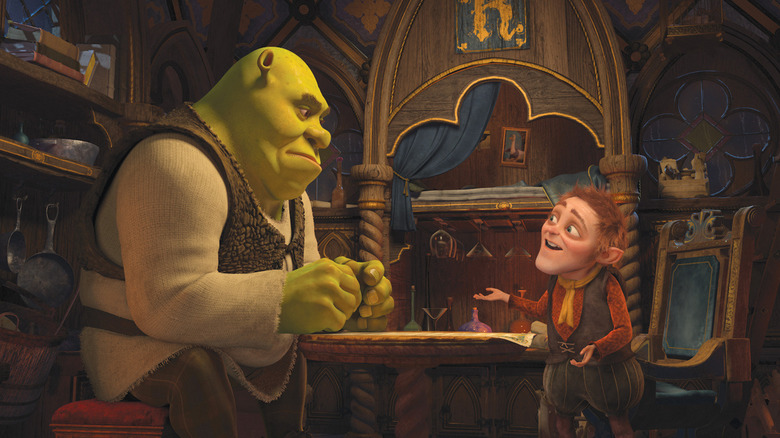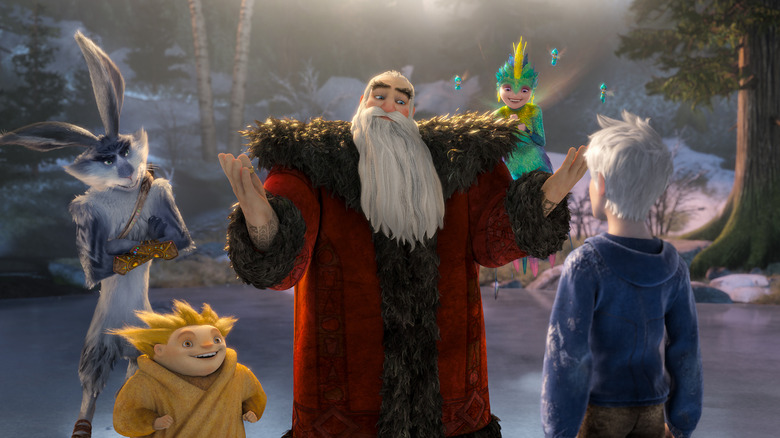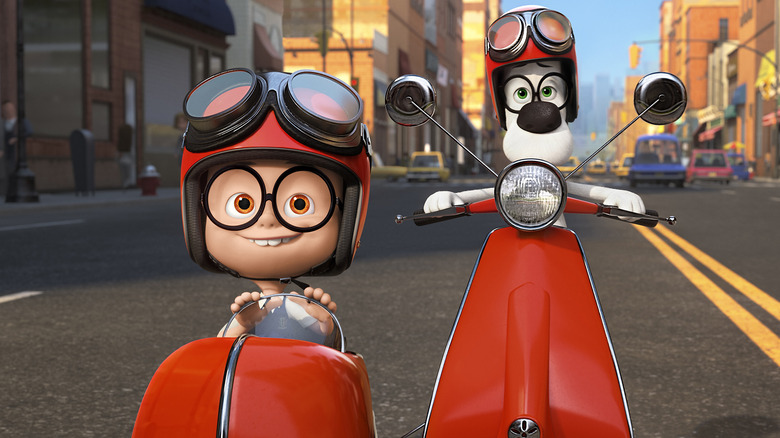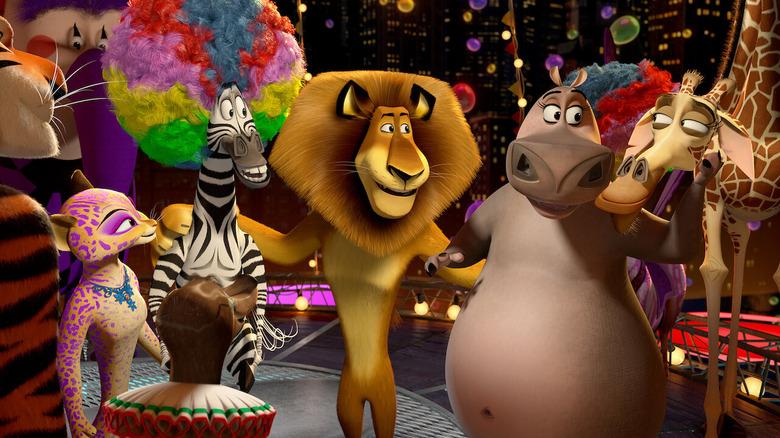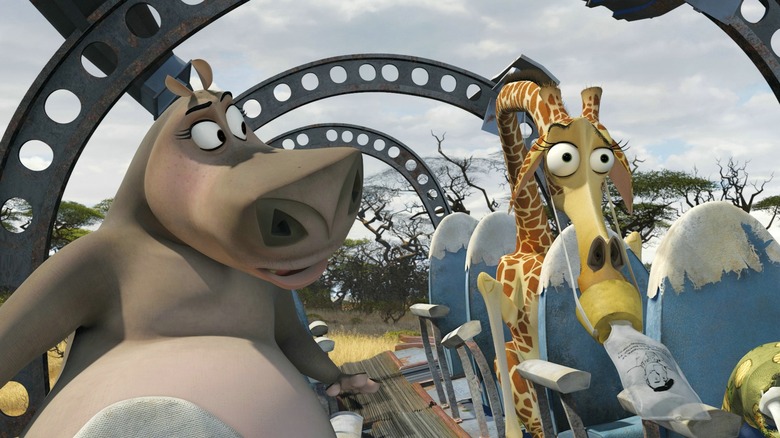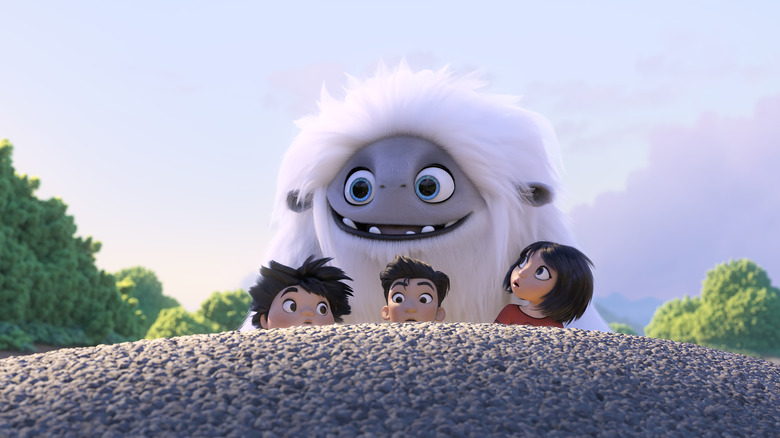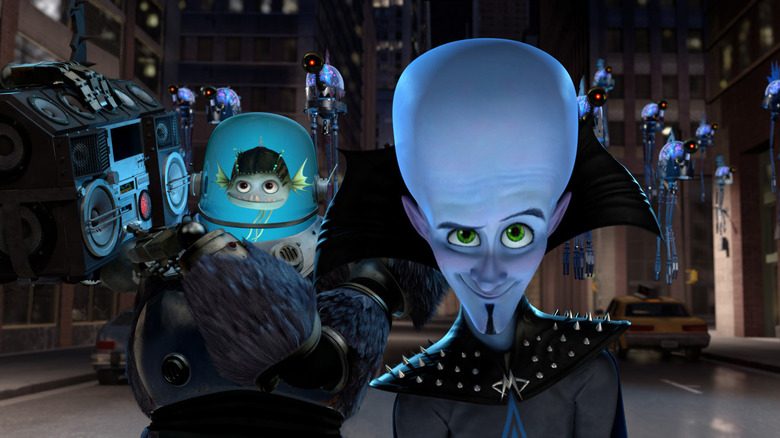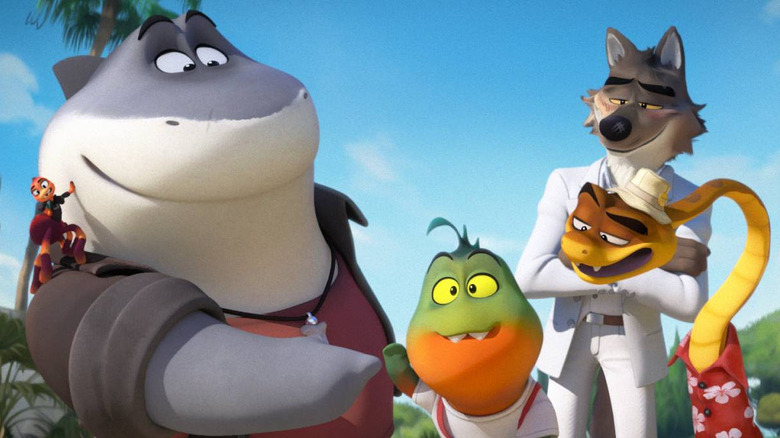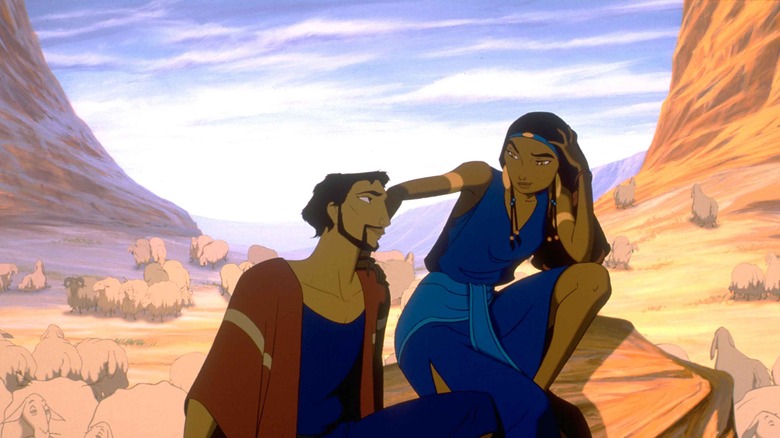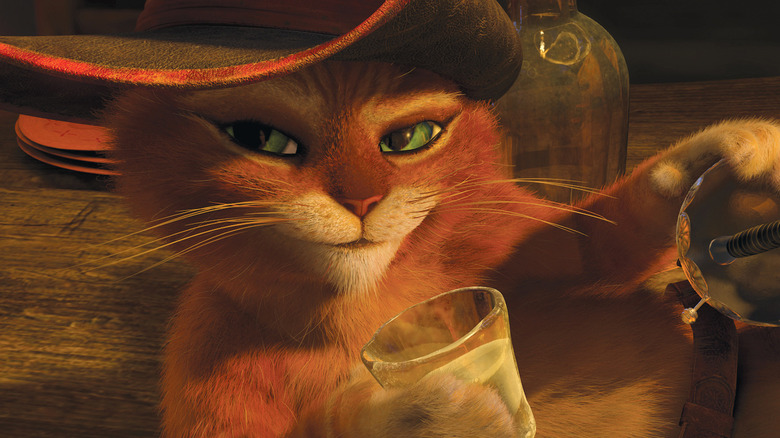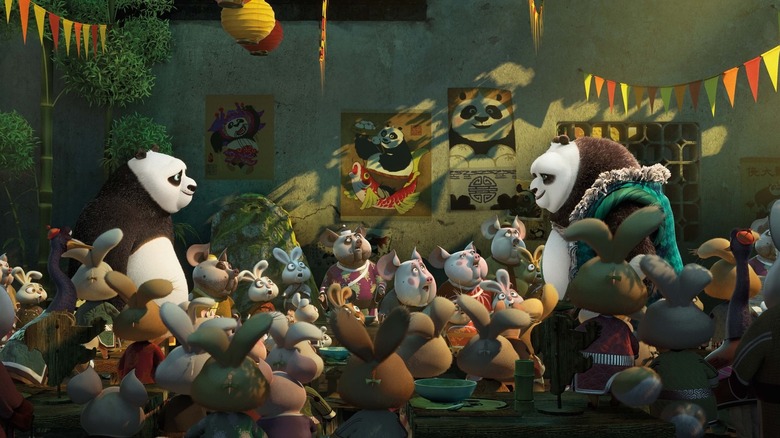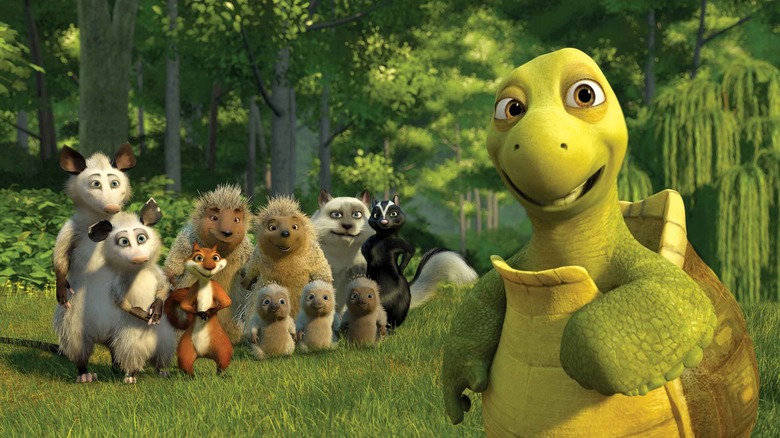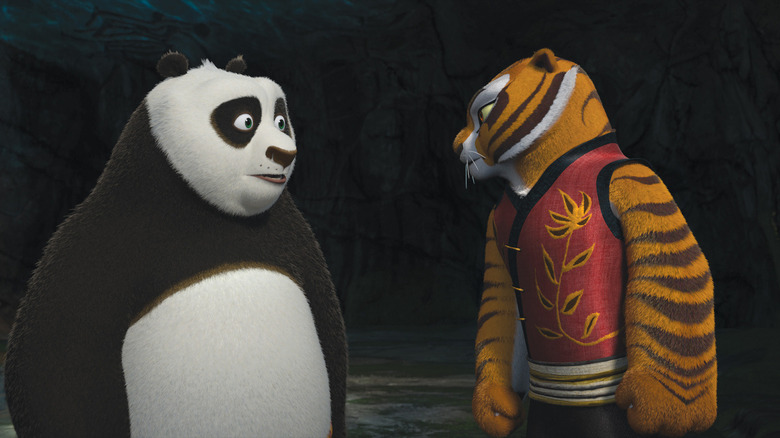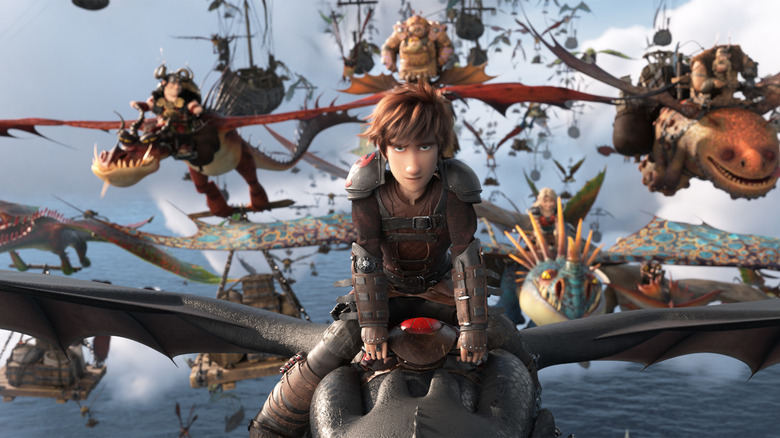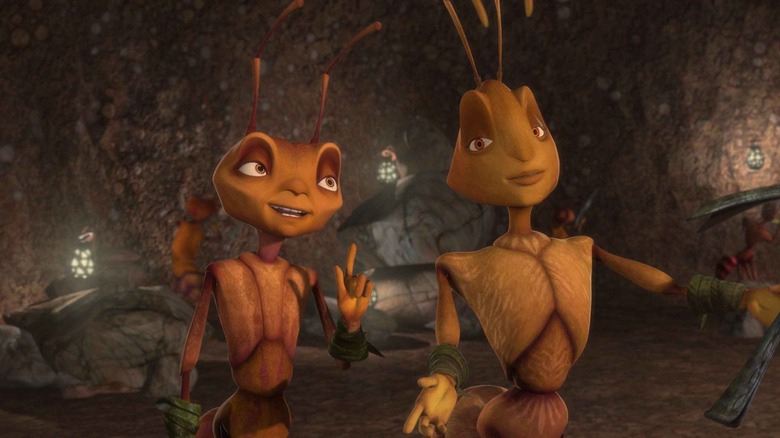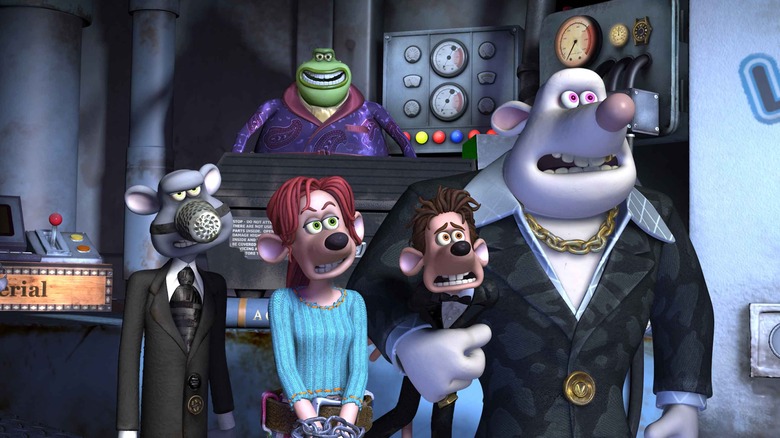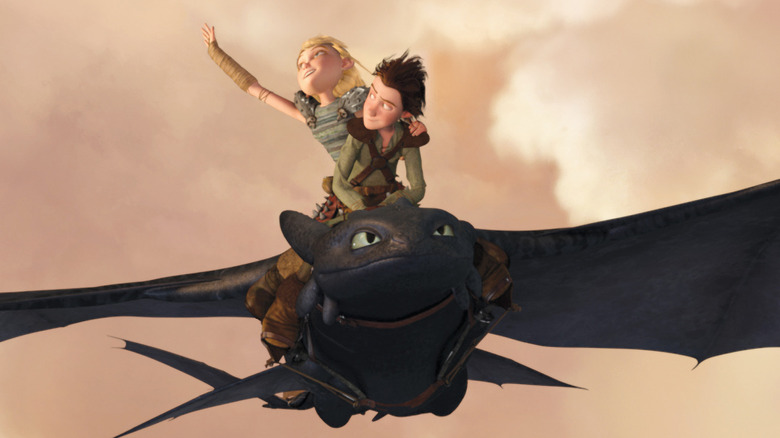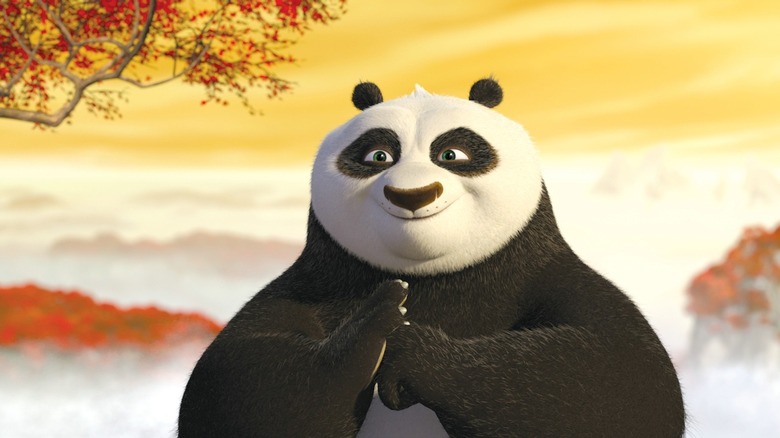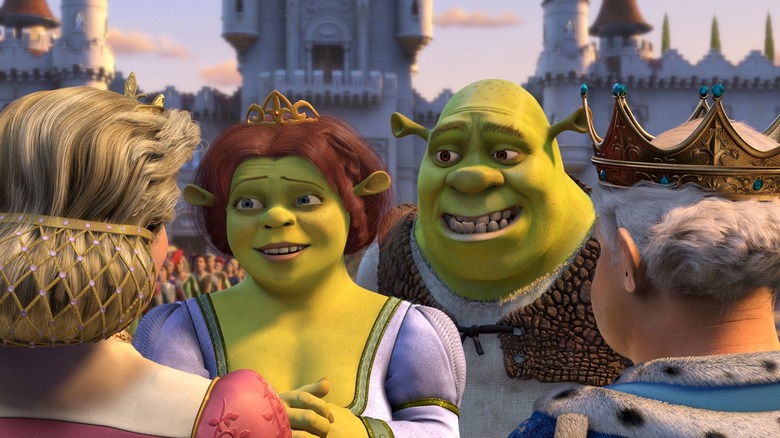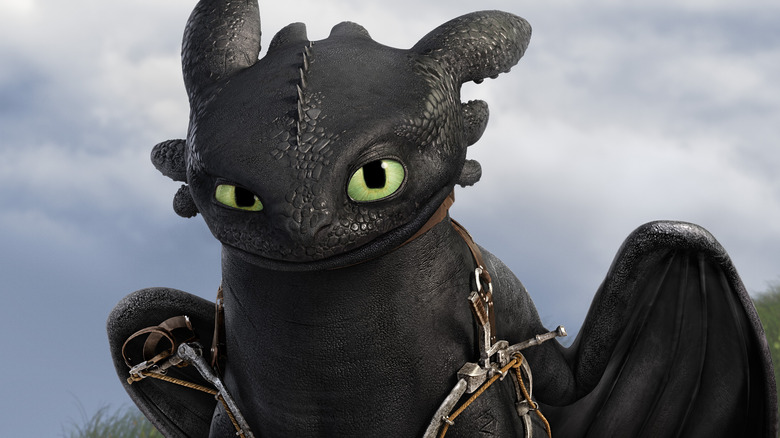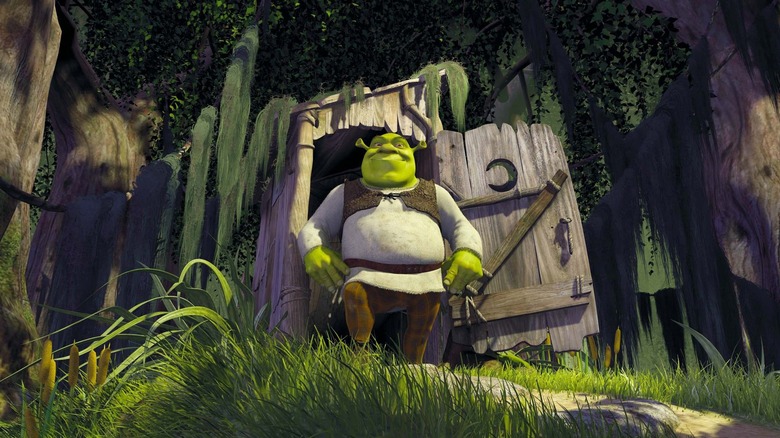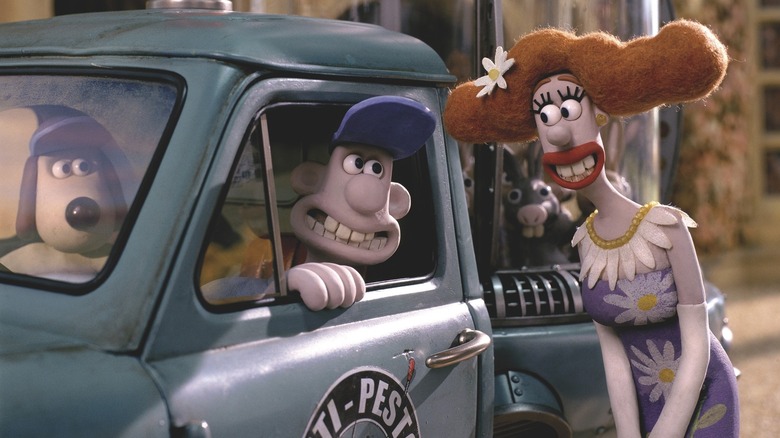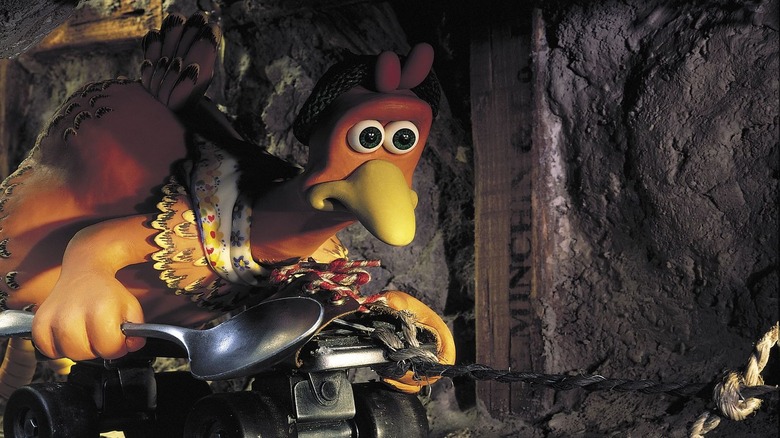Every DreamWorks Movie Ranked From Worst To Best
Ever since 1998, DreamWorks Animation has regularly produced new animated movies in various mediums (ranging from hand-drawn 2D imagery to stop-motion animation to largely CG-rendered projects) on a near-annual basis. In that time, the studio has delivered everything from wry takes on fairy tales to unusual interpretations of superhero yarns to glittery musicals and everything in-between. Having crafted a little over 40 feature-length motion pictures, DreamWorks Animation has truly gone all over the map. Not every DreamWorks Animation movie may be your all-time favorite film, but there's bound to be something in the studio's expansive filmography that resonates with you and your interests.
In delivering such a large amount of titles, the critical reception of the DreamWorks Animation library varies wildly. Some of the studio's titles were widely maligned and perceived as adhering to overly familiar hallmarks of traditional American animated cinema. But still, other productions from DreamWorks Animation have managed to score widespread acclaim and still stand as titles that resonate deeply with moviegoers worldwide. Ranking every DreamWorks Animation movie from worst to best makes one aware of this company's weaker titles, but you also get a sense of the broad scope of its general output and greatest achievements.
42. The Boss Baby: Family Business
The sequel to the 2017 feature "The Boss Baby," "The Boss Baby: Family Business" shifted its plot into the future to follow adult versions of the original film's two protagonists and added a new super-smart baby to the mix. Another noticeable deviation it delivered compared to its predecessor was its critical reception. The original "Boss Baby" was not a critical darling, but it still garnered significantly better marks than "Family Business," which was largely dismissed by critics. Carlos Aguilar of The Wrap aptly summed up a key recurring flaw that was often highlighted in the reviews for "Family Business" concerning how the plot was way too all over the map. For Aguilar, the inability of "Family Business" to focus on or flesh out any one thing left it feeling undercooked despite the movie throwing so much at the audience during its runtime.
Maya Phillips of The New York Times, on the other hand, was especially taken aback by the lack of fresh gags in "Family Business," with too many of this movies jokes coming off to Phillips as just rehashes of what the viewer saw in the initial "Boss Baby" installment. With this sequel, the "Boss Baby" franchise had failed to keep business booming creatively.
41. Sinbad: Legend of the Seven Seas
"Sinbad: Legend of the Seven Seas" may not be one of the most instantly recognizable titles in the DreamWorks Animation canon, but this was an important film in the studio's history. "Sinbad" was the final hand-drawn animated movie ever released by the company behind "Shrek." After releasing projects like "The Prince of Egypt" and "The Road to El Dorado," the financial shortcomings of "Sinbad" were so severe that then-head of DreamWorks Animation Jeffrey Katzenberg vowed that the studio would never use the medium again. This abandonment of a rich artform was a tragedy, but even more tragic was that the days of hand-drawn DreamWorks features had to end with a film as critically panned as "Sinbad: Legend of the Seven Seas."
For Tasha Robinson of The A.V. Club, the problem with "Sinbad" wasn't that it was devoid of merits. Robinson found individual elements of the film that clicked, but she also saw it as too often being beholden to standards of animated family cinema established by Disney. Per Robinson, "Sinbad" would've been a more consistently enjoyable enterprise if it had been as bold as its best assets. Lisa Schwarzbaum of Entertainment Weekly was even more critical in her review and took particular umbrage with Brad Pitt's vocal performance as the titular lead of "Sinbad," with this writer observing that Pitt's voice didn't fit a period setting. This was just one of many ways "Sinbad" failed to stay afloat.
40. Shark Tale
One of the earliest computer-animated DreamWorks Animation features, "Shark Tale" was a star-studded affair that featured the likes of Will Smith, Robert De Niro, and Martin Scorsese (among many others) in its cast. However, all those big names weren't enough to make this gangster movie pastiche click with critics. Generally, "Shark Tale" scored negative reviews, with a slew of flaws frequently brought up as reasons to give the movie a pass. Roger Ebert, though, pinpointed an especially egregious mistake with "Shark Tale" concerning how it didn't offer its target demographic, children, characters they could relate to. As Ebert put it, "Shark Tale" was a movie about decidedly adult problems like murder, debt, and infidelity. Would the kids who would inevitably come out in droves for this movie be interested in such storytelling material?
Lou Lumenick of The New York Post, meanwhile, was especially appalled how "Shark Tale" was crammed with outdated pop culture references and nonstop dialogue straining to get a laugh out of the audience. Even worse, Lumenick observed that the previous year's "Finding Nemo" showed off an infinitely better way to tell a family-friendly story about computer-animated fish. Unfortunately for everyone who went to see it, "Shark Tale" was no "Finding Nemo," not even close.
39. Spirit Untamed
Many DreamWorks Animation movies have become multimedia franchises, but few went down this road in as peculiar a fashion as "Spirit: Stallion of the Cimarron." First released in May 2002, "Spirit" delivered fine but not exceptional box office results for DreamWorks Animation. That seemed to be the end of this title and its prospects for inspiring follow-ups, but 2017 rolled around. This is when a Netflix animated TV show entitled "Spirit Riding Free," which carried over the horse character Spirit and nothing else from the original film, began to air. The program proved popular enough to inspire a new feature entitled "Spirit Untamed." The very existence of "Spirit Untamed" nearly two decades after "Spirit: Stallion of the Cimarron" premiered is a testament to the long-lasting appeal of that original film.
Unfortunately, the reviews for "Spirit Untamed" were nowhere near good enough to suggest that this title will be spawning its own unexpected sequels decades down the line. Yolanda Machado of The Wrap was disappointed in many aspects of the film, including its strange mixture of Spaniard and Mexican culture in depicting the hometown of its Latinx protagonist, a flaw that Machado saw as a byproduct of the lack of Latinx writers on major motion pictures. Other critiques of "Spirit Untamed" focused on the hollow sentimentality and generic voice acting, with such shortcomings making it apparent that "Spirit: Stallion of the Cimarron" should've remained a one-off in the DreamWorks Animation canon.
38. The Boss Baby
By 2017, director Tom McGrath had become one of the go-to filmmakers at DreamWorks Animation. Thanks to his work helming the three "Madagascar" films and "Megamind," McGrath had not only delivered several box office hits for the studio, but he'd made his affinity for stylized animation in the vein of classic "Looney Tunes" shorts apparent. His passions as a director were more prominent than ever with "The Boss Baby," his 2017 motion picture adapted from a children's book of the same name by Marla Frazee. Though the film had McGrath's fingerprints all over it, it being so uniquely him didn't help the film score much in the way of critical acclaim.
There were some pieces of praise placed upon "The Boss Baby," though, with Katie Rife of The A.V. Club commending the project's commitment to unyielding wackiness. By the same token, this same writer noted that "The Boss Baby" leaned too heavily on bathroom humor and generic chase sequences. Matt Singer of ScreenCrush, meanwhile, was impressed by how McGrath maintained his "psychedelic'" visual approach from earlier directorial efforts like "Madagascar 3: Europe's Most Wanted" but echoed Rife's complaints by lamenting how "The Boss Baby" became too noisy for its own good. "The Boss Baby" was at least successful in reflecting McGrath's most noticeable creative impulses, but it was a mixed bag otherwise.
37. The Road to El Dorado
In its initial March 2000 theatrical release, "The Road to El Dorado" was greeted with mixed reviews that just didn't think this buddy comedy lived up to its fullest potential. The recurring critiques of this project ranged wildly, with some taking fault with how the original songs penned by Elton John felt like an afterthought. Others were disappointed by the animation and especially by the derivative character designs, while still other critiques were centered on the lack of comedy found in the rapport between the disparate lead characters.
You didn't have to look far when "The Road to El Dorado" was first released for lengthy reviews breaking down the countless shortcomings of only the third DreamWorks Animation title. However, unlike many critically-maligned DreamWorks Animation titles, "El Dorado" has garnered a significant cult following. Decades after it first premiered, GIFs of comedic moments from the movie have become ubiquitous on the internet, while essays have been penned praising the feature's unique style of comedy. There's no denying that "The Road to El Dorado" has struck its own kind of gold with the resurgence of its fanbase, though that doesn't change the initial mixed critical reception it scored.
36. Trolls World Tour
Like many sequels, "Trolls World Tour" expanded on its predecessor by going bigger. Much bigger. In this case, "Trolls World Tour" would feature far more songs than the original "Trolls," but also a wider variety of types of trolls and even zanier visuals. "Trolls World Tour" wasn't looking to be a rehash of the first "Trolls," it wanted to deliver a show that audiences would be talking about for years to come. In the process of ballooning the scope to such a massive degree, though, "Trolls World Tour" succumbed to various shortcomings that informed its mixed critical reception.
Kristy Puchko for IGN, for one, was disappointed that "Trolls World Tour" assembled so many big-name actors and musicians (everyone from Ozzy Osbourne to Sam Rockwell was in the cast) yet settled for delivering something that only the youngest of moviegoers would be entertained by. Richard Lawson of Vanity Fair was no more impressed with "Trolls World Tour," with this writer feeling like the film hardly registered as a feature film. Instead, Lawson saw "Trolls World Tour" as just "a jumble of...music videos" that outstayed their welcome long before the credits began to roll. Nobody could say that "Trolls World Tour" didn't bring the expansive spectacle, but it also didn't bring much else to impress moviegoers with.
35. Spirit: Stallion of the Cimarron
After "Shrek" redefined what DreamWorks Animation movies could look and feel like, "Spirit: Stallion of the Cimarron," released one year later, brought the company back to doing films more akin to efforts like "The Prince of Egypt." "Stallion of the Cimarron" was a hand-drawn animated affair with a more serious tone (the lead horse didn't even speak beyond brief bursts of narration) that aimed to touch the soul, not deliver a barrage of gross-out gags. Though it deserved props for not just rehashing elements from DreamWorks Animation's biggest movie, "Spirit: Stallion of the Cimarron" still featured several noticeable shortcomings that critics harped on in their response to the feature.
For Dave Kehr of The New York Times, a big problem with "Spirit: Stallion of the Cimarron" was how, circa 2002, it felt trapped between different eras of animated family movies. Kehr just didn't feel that this title could live up to classical animated titles of the past while also perceiving "Cimarron" as a step down from more comedic animated projects that were fresh and new at the time. No matter how Kehr sliced it, "Stallion of the Cimarron" just felt like it came up short. Though it harkened back to formative animated films of yesteryear, "Spirit: Stallion of the Cimarron" fell short of becoming a new cartoon classic.
34. Penguins of Madagascar
From the moment they first appeared in the original "Madagascar" in 2005, those plucky Penguins have been fan-favorite characters. Skipper, Private, Kowalski, and Rico were fixtures of each installment in the "Madagascar" trilogy, and their notoriety seemed only to grow every time they appeared on-screen. Their enduring popularity inevitably produced a solo spin-off movie entitled "Penguins of Madagascar," which debuted in theaters in November 2014. Unfortunately, these characters were not quite as successful in anchoring an entire motion picture as they were at being scene-stealing supporting players, as seen by "Penguins of Madagascar" failing to stir up much enthusiasm from critics.
Scott Tobias of The Dissolve pinpointed that the bigger problem with "Penguins of Madagascar" was an overabundance of jokes, particularly ones aimed at grown-ups in the audience. Excess in terms of frantic action was another major complaint from Tobias, who did offer praise towards the voicework provided by John Malkovich as a nefarious octopus. Similar sentiments abounded in other reviews for the feature, including Geoff Berkshire's assessment of "Penguins of Madagascar" for Variety, which focused on how the film quickly dovetailed into repetitive mayhem despite some pleasing bits of animation. Though they had been good for supporting comic relief in the past, the titular birds of "Penguins of Madagascar" just couldn't sustain a solo feature film.
33. Bee Movie
In the years since it first hit movie theaters, "Bee Movie" has taken on a life of its own that far exceeds the film that inspired it. Whether it's avant-garde memes, T-shirts that cram in every line from the movie, or even Jerry Seinfeld himself noting that the ubiquitous "Bee Movie" internet memes inspired him to briefly make a sequel to this motion picture, it's clear that the internet's co-opting of "Bee Movie" has become inescapable. With this movie being so rampant on the web, it can be easy to forget that "Bee Movie" didn't garner much praise from critics when it was first released.
While the general reception to "Bee Movie" wasn't vehemently negative, the title scored mixed marks attributable primarily to the feature's strange narrative structure. Countless reviews pinpointed how "Bee Movie" struggled to figure out a storyline to focus on, which kept both the characters and comedy from working at their fullest potential. Other flaws included how Seinfeld's style of humor didn't translate well to the world of kid-friendly animation as well as the derivative animation. The internet has given "Bee Movie" a reputation as sweet as honey, but it's general critical reception paints a more complicated picture about the kind of buzz this picture has generated.
32. The Croods
Most prevalent across all reviews for "The Croods," even more so than assessments of the film's quality, were references to "The Flintstones." This computer-animated kid's movie about a family of cavepeople could not escape the shadow of that modern stone-age family from decades earlier. While "The Flintstones" cast a long shadow over pop culture, it's doubtful that "The Croods" would've been a critical darling even if that Hanna-Barbera sitcom had never existed. There were some deep issues with "The Croods" that made it understandable why critics essentially gave it a shrug.
Jessica Kiang of The Playlist did admit that "The Croods" had impressive computer animation and some flashy uses of digital 3D, but also felt that this emphasis on visual splendor was a problem. For Kiang, "The Croods" eschewed intimate character beats in favor of a deluge of spectacle that didn't work as it should without any engaging characters to work with. James Mottram of Total Film was similarly pleased by certain aspects of "The Croods," with his favorite moments coming in the comedic sequences of the project. However, he ultimately felt most viewers would be unable to remember anything about this feature after the credits finished rolling. With these kinds of reviews, families would likely be better off enjoying some reruns of "The Flintstones" rather than giving "The Croods" a watch.
31. Home
"Home" provided an opportunity for DreamWorks Animation to deliver an alien invasion movie, though this would be a much lighter affair than "Independence Day" or "Battle: Los Angeles." Not only would the extra-terrestrials be squishy critters primed and ready for the toy aisle, but they'd also be just as prone to starting up friendships with humans as they were to displace or capture them. Basically, this was an alien invasion movie as only the people behind "Shrek" or "Madagascar" could imagine it. That sense of familiarity when compared to other DreamWorks Animation movies turned out to be a problem for critics, whose mixed marks for "Home" largely centered on it being too derivative for its own good.
Michael Rechtshaffen of The Hollywood Reporter commended "Home" for not dragging in its pacing but was unable to shake the fact that the feature ended up reminding him of too many other computer-animated motion pictures. Without a strong sense of singular identity, "Home" proved largely disposable to this critic and so many others. Eric Henderson of Slant Magazine was also critical of how hollow the attempts at sentimentality were in "Home," with this writer finding none of the characters carrying the kind of depth necessary to make these moments of poignancy work like they should. Though it deviated from some norms of classic alien invasion movies, the critiques of "Home" was par for the course for middling DreamWorks Animation fare.
30. Trolls
With the 2001 film "Shrek," DreamWorks Animation made a direct rebuke to colorful fantasy musicals full of easy morals and overly cheerful characters. Ironically, by the time 2016 rolled around, the studio made the very kind of film "Shrek" was skewering with "Trolls." Based on the famous Troll dolls, "Trolls" was crammed with toe-tapping tunes and more colors than an explosion in a Crayola factory. Though not devoid of some snarky self-referential humor that wouldn't be out of place in a "Shrek" installment, "Trolls" was a largely straightforward exercise largely preoccupied with being happy. Committing to that aesthetic resulted in a movie that mainly garnered mixed reviews from critics, but even the most negative responses conceded that there was some glittery fun to be had here.
David Ehlrich of IndieWire's review of "Trolls" was a perfect summary of this consensus, with this writer noting that the film's tunes and upbeat vibes were more obnoxious than infectiously endearing. However, he did note that the proceedings were so energetic and often so bewildering that they could momentarily win over even the most cynical viewer. Keith Watson of Slant Magazine was a bit more upbeat in his breakdown of the feature, with Watson noting that the animation had just enough creativity to somewhat compensate for the forgettable screenplay. Nobody would deny that "Trolls" missed as many notes as it hit, but there were also defenders of this movie that ran counter to many hallmarks of classic DreamWorks fare.
29. The Croods: A New Age
Seven years after the original "Croods" premiered, "The Croods: A New Age" arrived in theaters to explore the further adventures of the titular prehistoric family. Centered on the Croods clan having to encounter a family of more advanced cavepeople, "The Croods: A New Age" received reviews that weren't bad, but also didn't make it seem like the long wait for this follow-up was worth it. Jenny Nulf of The Austin Chronicle was one of the many writers to pen a disapproving opinion of this feature, with Nulf being especially disappointed in how none of the many hyperactive antics in the screenplay ever resulted in the film getting much of a pulse or offering something super creative. More positive of Kate Erbland of IndieWire, who noted that this sequel didn't provide anything incredibly original but did appreciate several aspects of "A New Age," including the vocal performances of cast members like Kelly Marie Tran and Nicolas Cage.
Erbland also commended the project for delivering several enjoyably wacky prehistoric animals that could only be realized through animation. However, she did find the forms of conflict between the two prehistoric families to be far less innovative. "The Croods: A New Age" wasn't an essential sequel in the DreamWorks Animation canon, but it clearly garnered its share of fans who could rock out to its Stone Age antics.
28. Monsters vs. Aliens
By 2009, DreamWorks Animation had done parodies of fairy tale musicals, kung fu movies, and the Bing Crosby & Bob hope "Road To..." features, among other strains of cinema. With "Monsters vs. Aliens," the studio turned its eye towards skewering 1950s B-movies, an era that produced titles like "The Blob" or "Plan 9 from Outer Space." This being a DreamWorks production, the approach to paying tribute to such titles would include lots of pop culture references, celebrity voice-overs, and wall-to-wall gags. "Monsters vs. Aliens" and its attempts to provide a 21st-century nod towards cheap movies of yesteryear yielded a wide spectrum of responses, with many critics simply being unimpressed with everything this project had to offer.
Joe Morgenstern of The Wall Street Journal was one critic who was especially disappointed with this venture, particularly on a narrative level. Save for Seth Rogen's B.O.B. character, Morgenstern found little to recommend in a film that couldn't wring much fun or imagination out of its high-concept premise. Ty Burr of The Boston Globe also found the screenplay for "Monsters vs. Aliens" severely lacking but did note that the film provided enough digital 3D spectacle to make it a painless watch for parents. "Monsters vs. Aliens" wasn't perceived as a monstrous cinematic experience, but its general critical reception didn't point to something that was out of this world either.
27. Madagascar
With "Madagascar," DreamWorks Animation managed to launch its second computer-animated franchise after "Shrek." The story of four animals from the Central Park Zoo ending up on the island of Madagascar turned out to be a recipe for box office success, particularly since this yarn also involved a quartet of wacky penguins whose cute appearance masked a ruthless demeanor. While an undeniable hit with audiences, "Madagascar" scored a much more complicated reaction from critics. Those who did give favorable responses to the film were generally pleased by how "Madagascar" did deliver as a comedy. Claudia Puig for USA Today, for instance, appreciated the lively voice work from actors like Sacha Baron Cohen and Ben Stiller, which she felt kept the movie consistently entertaining enough to paper over an under-sketched narrative.
On the other hand, Dana Stevens of The New York Times was shocked at how hollow "Madagascar" was despite so many big-name artists and advanced computer-animation tools was used to bring it to life. Across all reviews for "Madagascar," positive and negative, there was an agreement that this particular DreamWorks Animation movie just wasn't as substantive as it could be. However, for some, the gags were funny to make it a passable diversion.
26. Turbo
There have been many underdog stories in the history of animated filmmaking. But only "Turbo" shifted this subgenre into the next gear by making an under-snail story about an average garden snail named Turbo (Ryan Reynolds) who gets super-speed after a freak accident. Naturally, he decides to use this new gift to race against a horde of automobiles in the Indy 500. Part "Cars," part "Ratatouille," and part fever dream, "Turbo" is an unabashedly wacky project, the kind that could only hope to exist in the limitlessly imaginative space of animation. For some critics, the flagrantly strange nature of "Turbo" was enough to make it a winner, while other critics were more mixed on this inspirational tale.
A.O. Scott of The New York Times fell into the latter camp, with this writer being disappointed that "Turbo's" idiosyncratic premise was executed with few flourishes to make it stand out from your average computer-animated kid's movie. Betsy Sharkey of The Los Angeles Times, meanwhile, was left amused by this unusual concoction mainly because of the voice cast, which contained energetic turns from the likes of Paul Giamatti and Bill Hader. While few critics believed "Turbo" crashed and burned, there was sharp division on whether or not this interpretation of an underdog yarn made it into the winner's circle or not.
25. Shrek the Third
The first two "Shrek" movies had their detractors, but by and large, these inaugural installments in the "Shrek" saga were well-received productions. Their general critic response practically looked like the glowing reception to the best Pixar movies compared to the reviews that greeted the debut of "Shrek the Third." The first installment of this saga not to be helmed in some capacity by director Andrew Adamson, "Shrek the Third" was seen as a significant step down from the last two adventures anchored by this grouchy ogre. Tasha Robinson of The A.V. Club was one of the most vocally disdainful voices regarding this installment. Robinson was baffled that this sequel delivered drastically fewer jokes and less energy than its predecessors. The unusually meek nature of Shrek's personality also caught Robinson's ire and served as a microcosm for this reviewer of how "Shrek the Third" was just going through the motions.
Kirk Honeycutt of The Hollywood Reporter was a touch more positive on "Shrek the Third" in his review, lending praise to some aspects like the quality of the computer animation. Still, like Robinson, he felt the gags were a massive step down from earlier "Shrek" installments and lamented that the freshness that defined this saga was in short supply. With "Shrek the Third," the saga that used to be the golden child of DreamWorks Animation finally had some unmistakable rust grafted onto it.
24. Shrek Forever After
Though it can be easy to forget in an era of ongoing narratives like the Marvel Cinematic Universe, for the most part, all movie franchises must eventually end. For "Shrek," this moment came in the 2010 installment "Shrek Forever After." Arriving nearly a decade after this ogre burst out of his swamp and into the hearts of moviegoers across the globe, "Shrek Forever After" offered an opportunity for the "Shrek" saga to go out on a high note and recover from the mixed marks of "Shrek the Third." While "Shrek Forever After" didn't necessarily send the saga out with a whimper, its general critical reception also didn't do much to improve the reputation of "Shrek" sequels made after the year 2004.
Mary Pols of Time Magazine observed that "Shrek Forever After's" most significant problem was how it employed narrative beats and gags that would be so familiar to general moviegoers yet belonged to a franchise that once prided itself on being decidedly modern and groundbreaking. While expressing amusement over characters' antics like Donkey and Puss in Boots, Pols still felt that "Shrek Forever After" was bogged down by adherence to formulaic storytelling tendencies. This sentiment echoed throughout most of the reviews for "Shrek Forever After," which suggested this was a less than ideal conclusion for the "Shrek" saga.
23. Rise of the Guardians
"Rise of the Guardians" opens with a shot of a teenage body sinking to the bottom of a pond. The boy has died, and when he awakens, he will have no memory and eventually becomes the figure known as Jack Frost (Chris Pine). This is an unusually dark opening for a movie hailing from the studio behind "Madagascar" and "Shark Tale," but director Peter Ramsey is clearly aiming to deliver something a bit more thoughtful and atmospheric with his unique vision of childhood icons like Santa Claus or the Easter Bunny. The bold ambition behind this family film ended up impressing some critics but also left others cold.
Justin Chang of Variety was an example of somebody who felt "Rise of the Guardians" was all colorful hyperactivity without much in the way of humanity or pathos to ground everything. For Chang, "Guardians" was way too frantic to ever feel like something imbued with actual magic. More positive in his breakdown of "Rise of the Guardians" was Bilge Ebiri for Vulture, who felt the film delivered enough imagination and visual spectacle to make it a profoundly entertaining viewing. Though it had a sizeable amount of detractors, the unique tendencies of "Rise of the Guardians," like that bold opening sequence, were enough to infect some critics with supportive holiday cheer.
22. Mr. Peabody & Sherman
While Pixar Animation Studios has entirely eschewed the practice of adapting previously existing materials for movies, DreamWorks Animation has never had a problem with this practice. "The Prince of Egypt," after all, was based on the Biblical tale of The Ten Commandments, while "Shrek" was originally a children's book by William Steig. DreamWorks Animation and its fondness for adaptations has continued throughout its history and has even included a motion picture based on a duo that originated in cartoon shorts from Jay Ward. The 2014 film "Mr. Peabody & Sherman" brought the titular canine father and adopted human son to the big screen for the first time and also translated fixtures of hand-drawn TV animation into splashy CG animation. Some critics were amused by this 21st-century interpretation of these characters, though there was a general feeling of indifference to the production in many other corners.
Despite being about a talking dog and his time machine, Drew McWeeny of Hitfix was disappointed that "Mr. Peabody & Sherman" wasn't stranger. This critic found that the film emphasized predictable sentimentality over all the farcical comedic possibilities of time travel antics, and "Mr. Peabody & Sherman" suffered for it. Even more positive assessments of the feature, like Matt Zoller Seitz's review for RogerEbrt.com, still noted that this particular DreamWorks Animation adaptation was too beholden to formula to match the unpredictable wit of its source material.
21. Madagascar 3: Europe's Most Wanted
The "Madagascar" trilogy came to a close with "Madagascar 3: Europe's Most Wanted," which, as the title indicates, brought those brave New York animals to a variety of lavish European locales. The zaniness also got ramped up to eleven with this installment, particularly for a lengthy circus performance sequence set to Katy Perry's "Firework" that channeled the visual aesthetic of the "Pink Elephants on Parade" set-piece from "Dumbo." These unique touches informed some of the most praiseworthy reviews "Europe's Most Wanted" received, though plenty of critics were unmoved by all the colorful chaos.
Amy Biancolli of The San Francisco Chronicle was one of many critics who found "Europe's Most Wanted" to be way too fast-paced for its own good, with this writer struggling to appreciate the gags or animation with how quickly this feature zipped through every plot point it tackled. On the other hand, Betsy Sharkey of The Los Angeles Times was dazzled by the colorful visuals of the film and felt that both the animation and the comedy packed enough of a wallop to compensate for the familiarity of the narrative. Though not an essential sequel by any means, "Madagascar 3: Europe's Most Wanted" scored enough praise to suggest it was a fun time under the big top.
20. Madagascar: Escape 2 Africa
Looking at the "Madagascar" trilogy as a whole, it's a bit shocking how "Madagascar: Escape 2 Africa" is the most emotional of the three movies. Granted, the wacky tendencies of this entire franchise isn't eschewed, thanks to the presence of a violent granny and a Hippo named Moto Moto. But this title also makes room for bittersweet scenes of Alex the Lion (Ben Stiller) struggling to connect with his father and melancholy informing the unspoken romantic affection Melman the Giraffe (David Schwimmer) has for Hippo Gloria (Jada Pinkett-Smith). Such a heavy presence of poignancy did make "Escape 2 Africa" a bit of a tonal outlier in this saga, though it also helped it to win over some critics who may have been indifferent to a "Madagascar" sequel.
Roger Ebert, for one, found the Melman/Gloria romance to be "touching" and noted that the heavier presence of pathos in the production had resulted in a "more engaging" film than the original "Madagascar." However, for someone like Manohla Dargis of The New York Times, the predictability of "Escape 2 Africa's" script and a voice cast too reliant on star power led to a movie that just wasn't as enjoyable as it could've been. Though opinions like the one voiced by Dargis were prominent in the critical reception to this production, "Escape 2 Africa" and its greater emphasis on heartache still pleased more critics than it didn't.
19. Abominable
"Abominable," a directorial effort from Jill Culton, was built on the classic kids movie foundation of an adolescent character befriending an otherworldly creature that behaves like an everyday pet. It worked well for "How to Train Your Dragon," so it's no surprise that DreamWorks Animation returned to this formula for "Abominable," which concerned a teenage girl befriending a Yeti that needs to get back to his home. The majority of the reviews for "Abominable," even the positive ones, took note of how this motion picture was treading familiar ground for kid-oriented cinema. For some critics, there was enough charm here to overcome the well-trodden narrative foundation, but others were unable to get immersed in something so derivative.
Katie Walsh of The Chicago Tribune was one writer who found the familiarity of "Abominable" to be an advantage since it provided a sturdy template for Culton and the animation team to hang gorgeous-looking sequences onto. For Walsh, the point here was not to redefine a traditional kid movies narrative but to dazzle the audience and touch their hearts, which she felt "Abominable" did successfully on both fronts. However, Peter Bradshaw of The Guardian summed up the dominant critiques of "Abominable" by lamenting the lack of bold creative choices or exciting verve in the feature, with Bradshaw finding it to be more tedious than affecting. These and other reviews make it clear that one's enjoyment of "Abominable" will rest on a personal tolerance for familiar storytelling.
18. Megamind
Given the ubiquity of superhero films in the 21st century, it's more than a touch surprising that it took until 2010 for DreamWorks Animation to offer its own take on the popular subgenre with "Megamind." Centered on a super-intelligent blue supervillain (voiced by Will Ferrell), the production was a riff on the Superman mythos and also asked the question of whether or not a supervillain could become a superhero. Even more than all of that, it also offered up plenty of opportunities for slapstick, pop-music needle drops, and other staples of DreamWorks comedies. Putting all these ingredients together didn't quite make the next "The Incredibles" among superhero parodies, though "Megamind" certainly got better marks than titles in this subgenre like "Superhero Movie."
Lou Lumenick of The New York Post was one critic who was crestfallen that "Megamind" reflected DreamWorks Animation's return to its more commercial and predictable impulses after subverting expectations with "How to Train Your Dragon" that same year. However, the general reception to "Megamind" included several positive reviews like an assessment from Owen Gleiberman of Entertainment Weekly, with this reviewer appreciating how the project delivered lighthearted fun and plenty of pleasing imagery that popped in digital 3D screenings. Though not quite "super," many critics were largely pleased with "Megamind's" skewering of comic book movie conventions.
17. The Bad Guys
Only the second non-sequel released by DreamWorks Animation since 2017, "The Bad Guys," an adaptation of the popular children's book series of the same name by Aaron Blabey, focused on a group of animal criminals. After getting arrested, this gaggle of ne'er-do-wells initially plan to act like they're reforming their ways while secretly planning a new elaborate heist. Featuring the likes of Sam Rockwell and Marc Maron in its voice cast, "The Bad Guys" was a spin on heist films that also mimicked the camerawork and dialogue seen in motion pictures helmed by the likes of Guy Ritchie and Quentin Tarantino. All these influences together in a kid-friendly package could've resulted in something disjointed, but critics were, by and large, amused by the mischief that "The Bad Guys" got into.
Jesse Hassenger of Polygon conceded that "The Bad Guys" would never get points for originality, even when just considering the other animated films it was derivative of. However, Hassenger also noted that "The Bad Guys" was largely zippy and entertaining enough to make that less of a pressing issue than it otherwise might be. James Berardinelli of Reel Views, meanwhile, found this movie's script forgettable but was most impressed with "The Bad Guys" when it came to its unique animation style. With these kinds of marks, "The Bad Guys," though far from flawless, proved DreamWorks Animation could still deliver something original and enjoyable.
16. The Prince of Egypt
The first hand-drawn animation title released by DreamWorks Animation, "The Prince of Egypt" was an appropriately momentous feature for the equally important place it occupied in the history of this studio. Retelling the saga of Moses and the Ten Commandments, "The Prince of Egypt" was a musical epic that attempted to tell a grand story unlike anything else seen in mainstream American animation up to this point. This wasn't a movie trying to mimic the beats and storytelling hallmarks of influential Disney films like "The Lion King" or "Aladdin." "The Prince of Egypt" wanted to be in a class all of its own. The critical reception to "The Prince of Egypt" wasn't quite strong enough to live up to those lofty aspirations, but it was still generally warm.
For SF Examiner, Juan M. Mendez praised "The Prince of Egypt's" animation, but was more critical of a tone that he perceived to often be too "tedious" for its own good. Glenn Lovell of Variety, on the other hand, felt that "The Prince of Egypt" matched its massive ambitions and even felt it managed to outdo Cecil B. DeMille's 1956 film "The Ten Commandments" as the ultimate cinematic retelling of Moses's story. The initially positive but restrained response has given way to a much more beloved reputation over time, with the likes of Jessica Toomer of Syfy dubbing "The Prince of Egypt" "the greatest animated film of all-time" in 2019.
15. Puss in Boots
The track record for prequel spin-off movies focusing on scene-stealing supporting characters isn't great. "Solo: A Star Wars Story" couldn't get audiences to care about Han Solo as a leading man, while the artists at Pixar struggled to make "Lightyear" as big as the "Toy Story" movies that spawned him. This seemed to set the stage for "Puss in Boots" to become the latest example of a franchise misunderstanding that supporting players are often supporting for good reason. But then a funny thing happened. "Puss in Boots" got solid reviews and noticeably better marks than the last two "Shrek" installments to boot. Nobody is dubbing this feature an essential motion picture by any means, but "Puss in Boots" was largely well-liked, especially compared to other similar spin-offs.
Peter Debruge of Variety was one of many critics to acknowledge that "Puss in Boots" was made solely to squeeze more dollars out of anything connected to the "Shrek" universe. However, also like many other critics, Debruge praised "Puss in Boots" for managing to work as a standalone movie with unexpectedly clever writing and voice-over performances. Jennie Punter of The Globe and Mail echoed these sentiments and also lavished special praise on the film's action sequences. While many other supporting characters have tried and failed to leap to leading man status, critics largely agreed that "Puss in Boots" had nailed this transition.
14. Kung Fu Panda 3
Po the Panda faced many foes across the trilogy of "Kung Fu Panda" movies, ranging from his internal self-doubts to a monstrous snow leopard to a peacock with a thirst for vengeance. But in "Kung Fu Panda 3," he encountered an incredibly daunting adversary: the critical track record of threequels. Many third installments in popular animated movie franchises had ended up getting dismissed by critics. Exceptions like "Toy Story 3" existed, but productions like "Shrek the Third" or "Ice Age: Dawn of the Dinosaurs" were the order of the day in terms of what kind of critical response these movies garnered. While "Kung Fu Panda 3" couldn't conquer all of the problems these kinds of sequels were usually plagued by, it did get better than usual marks for an animated threequel.
For Kimberley Jones of The Austin Chronicle, the biggest reason to see "Kung Fu Panda 3" was to soak in the outstanding animation, which was filled with colorful and stylized imagery whenever the plot shifted into a realm populated by spirits. Bill Zwecker of The Chicago Sun-Times, meanwhile, felt that the film did a good job at reinforcing why Po the Panda was such an engaging and relatable protagonist across all three "Kung Fu Panda" installments. Even if critics didn't feel it quite lived up to its predecessors, "Kung Fu Panda 3" was still received well enough to make it much more than a cash-grab sequel.
13. Over the Hedge
In 2006, the Michael Fry and T. Lewis comic strip "Over the Hedge" became an animated film of the same name hailing from DreamWorks Animation. The exploits of scheming raccoon RJ (Bruce Willis) and cautious turtle Verne (Gary Shandling) were getting brought to the big screen, complete with the sharp commentary on modern suburban life that its source material was built upon. Translating these characters to a motion picture resulted in a comedy that played well with critics, who, by and large, got some laughs out of these woodland critters navigating the sudden presence of humans, houses, and minivans in the place they used to call home.
Roger Ebert did express mild disappointment that the "Over the Hedge" movie wasn't quite as thoughtful as its comic strip source material. However, he did find it to be more amusing and charming than other animated kids movies coming out at the same time and walked away generally pleased with the production. For Lisa Schwarzbaum of Entertainment Weekly, "Over the Hedge" registered as a funnier than usual DreamWorks outing and singled out the star-studded voice cast and the consistently amusing gags as the primary reason to give "Over the Hedge" a shot. Though the "Over the Hedge" comic strip isn't a household name property, these kinds of reviews make it clear that translating it into an animated family comedy was a wise notion.
12. Kung Fu Panda 2
The original "Kung Fu Panda" wasn't just a terrific animated movie, it was also a bolt out of the blue that redefined expectations for what a DreamWorks Animation movie could be. The only issue with accomplishing such impressive feats was that it set the bar so high for "Kung Fu Panda 2." The first feature-length extension of Po the Panda's universe, critics didn't dub "Kung Fu Panda 2" as being superior to its predecessor. However, it was greeted with positive reviews that indicated nobody needed to worry that this follow-up had damaged the reputation or sanctity of the "Kung Fu Panda" universe.
Angie Errigo for Empire Magazine praised "Kung Fu Panda 2" for going deeper in its emotions than its predecessor and especially for the poignancy of flashbacks to Po's childhood. She also had positive affirmation for the filmmaking from director Jennifer Yuh Nelson and Gary Oldman's voice-over work as new villain Lord Shen. Todd McCarthy of The Hollywood Reporter, on the other hand, primarily focused on the visual wonders of "Kung Fu Panda 2" in his positive review, with this writer declaring the animation to be even better thanks to the presence of digital 3D projection. It was a momentous task to make a sequel worthy of the first "Kung Fu Panda," but critics largely agreed that "Kung Fu Panda 2" was more than up to the task.
11. Captain Underpants: The First Epic Movie
The "Captain Underpants" books by Dav Pilkey have never pretended to be especially intellectual pieces of literature. After all, these are children's books where a hefty adult man fights sentient toilets and an evil scientist named Professor Poopypants while wearing only a cape and his tighty-whiteys. But the juvenile sense of humor that fuels these adventures has made this series a favorite for kids and even some grown-ups in touch with their inner child. The unabashedly childish nature of this saga was maintained for the DreamWorks Animation movie adaptation "Captain Underpants: The First Epic Movie." Per the critical reception to this title, "The First Epic Movie" mimicked its source material in appearing to be a hollow deluge of bathroom humor but concealing some sharp wit underneath.
Matt Zoller Seitz of RogerEbert.com was one of many critics to attest to the unexpectedly fun power of "Captain Underpants: The First Epic Movie," with Seitz being especially enamored with Nick Kroll's go-for-broke vocal performance as Professor Poopypants, Esq. Katie Walsh of The Los Angeles Times also found this title to be a hoot and especially enjoyed the little visual flourishes, like an extended gag told through sock puppets, that gave "The First Epic Movie" memorable comedic style. With these generally positive reviews, "Captain Underpants: The First Epic Movie" reaffirmed the power of well-executed immature humor.
10. How to Train Your Dragon: The Hidden World
The saga of Hiccup, Toothless, and all the residents of Berk and their dragons came to an epic conclusion with "How to Train Your Dragon: The Hidden World." In an age where animated sagas like "Toy Story" and "Despicable Me" seem to go on forever with endless sequels and spin-offs, "How to Train Your Dragon" provided a welcome departure from the norm in its commitment to a definitive conclusion. However, "The Hidden World" was consistent with the past in terms of scoring a critical reception that mirrored the reviews garnered by its predecessors. Much like the first two "How to Train Your Dragon" installments, "The Hidden World" was considered a total winner for kids and adults.
Peter Travers of Rolling Stone went so far as to declare "The Hidden World" to not be just as good as earlier "Dragon" adventures, but even better. This was thanks to the movie focusing on wondrous beauty rather than hyperactive comedy in sequences like Toothless soaring across the sky with a dragon he's romantically infatuated with. Hope Corrigan of IGN also had nothing but positive things to say about "The Hidden World" and was especially impressed with how well it built on its predecessors to create unforgettably moving payoffs for characters like Hiccup and Toothless. "How to Train Your Dragon: The Hidden World" was the end of the road for this saga, but at least it sent the story out on a high note.
9. Antz
The very first DreamWorks Animation movie released to the public, "Antz" was a historic movie for this studio. Fittingly for such a momentous movie, "Antz" was a spectacle, even just by its voice cast. While the voice of Z the ant was played by Woody Allen, the supporting voice actors in the movie included everyone from Sylvester Stallone to Gene Hackman to Christopher Walken and so many more. All of these famous voices collided in a feature that ended up getting positive marks from critics and was even better received than "The Prince of Egypt," the other DreamWorks Animation movie from 1998.
For Roger Ebert, what stuck out about "Antz" was how it was "not a children's movie" per se, but rather a film that was able to entertain people of varying ages. He was also impressed with the vast imagination reflected in its animation and how "Antz" embraced imagery that could never be possible in live-action filmmaking. David Denby of New York Magazine, though, was most pleased with the comedy in "Antz" and, much like Ebert, felt that adults would be getting even more out of the gags than the adolescent viewers. Right out of the gate, DreamWorks Animation managed to deliver something acclaimed and unique, a harbinger of what would come from future beloved titles in its library.
8. Flushed Away
With "Flushed Away," an end of an era had arrived for DreamWorks Animation. This comedy marked the final title in the studio's partnership with Aardman Animation. Much had changed in the years since the two companies struck a deal to work together in 1998, with DreamWorks Animation finding its footing with titles like "Shrek" while collaborations with Aardman like "Flushed Away" ended up losing money at the box office. Thankfully, "Flushed Away" could serve as more than just a manifestation of how two animation studios had grown apart. The glowing reviews for "Flushed Away" clearly indicated that this was another Aardman film that had gone over like gangbusters with critics.
A.O. Scott of The New York Times sang the praises of "Flushed Away" for, among other qualities, being unapologetically "silly" and for delivering so much comedy. Olly Richards of Empire Magazine was similarly enthusiastic about "Flushed Away" and even went so far as to dub it the greatest animated movie of 2006. In comparing it to past Aardman efforts, Richards proclaimed that "Flushed Away" was only a bit behind the antics of Aardman icons Wallace & Gromit in terms of overall quality. Though bittersweet events surround its place in the history of DreamWorks Animation, "Flushed Away" is still one of the studio's better received efforts.
7. How to Train Your Dragon
"How to Train Your Dragon" was brought to the silver screen through the directorial duo of Chris Sanders and Dean DeBlois. Having migrated over from Walt Disney Animation Studios after delivering "Lilo & Stitch" for that studio, the pair was able to deliver another acclaimed movie about an adolescent character bonding with a dangerous but cuddly critter with "How to Train Your Dragon." Critics didn't hold back any praise in describing their enjoyment of this title, with many declaring that this project soared as much as the dragon within its own story.
Keith Phipps of The A.V. Club was astounded by the animation in "How to Train Your Dragon" and was especially blown away by the "impressive use of 3D" that utilized this projection format for far more than just shallow gimmicks. However, the story beats and characters of "Dragon" are what really made this title stand out to Phipps and helped cement it as something that deeply moved him. For Claudia Puig of USA Today, though, it was Toothless the dragon that made "Dragon" an instant classic, with this reviewer noting that his antics were guaranteed to warm the heart of even the most cynical viewer. With these and other euphoric reviews for "How to Train Your Dragon," it's clear the film's directors had delivered the emotionally stirring goods and then some.
6. Kung Fu Panda
The final act of "Kung Fu Panda" is kicked off by Po the Panda realizing that "there is no secret ingredient" to being the Dragon Warrior. What makes you distinctly yourself is also what makes you worthy of being the Dragon Warrior. In reviewing this inaugural installment of the "Kung Fu Panda" saga, the widespread positive reviews from critics tended to praise this movie for taking cues from this moral. "Kung Fu Panda" was something special in the history of DreamWorks Animation because it had the confidence to follow its creative instincts rather than settle for adhering to the staples of classic titles from the studio.
Richard Corliss of Time Magazine was delighted that "Kung Fu Panda" reminded him less of "Shrek," but more of Hong Kong action films like Stephen Chow's "Kung Fu Hustle." This was a testament to the sharpness of the film's narrative as well as the craftsmanship that had gone into the action sequences. As for Tasha Robinson of The A.V. Club, she was dazzled by the film's visuals and its commitment to displaying an infectious love for classic martial arts movies. Good filmmaking, like the kind that was commented on throughout the reviews for the original "Kung Fu Panda," is just as powerful as any Kung Fu fighting style.
5. Shrek 2
With "Shrek 2," the titular ogre went even farther away from his swamp and into the bustling land of Far, Far Away. Here, Shrek (Mike Myers) would meet the parents of Fiona (Cameron Diaz) while navigating the concept of what would make his new wife happy. It was a premise that retained the heart of the original "Shrek," but also found time for new characters (most notably Puss in Boots) as well as big showstopper set-pieces, like a mad dash to a castle set to "Holding Out for a Hero." All of these ingredients coalesced into a movie that wasn't just a box office phenomenon, but also a critically-acclaimed venture.
Carrie Rickey of The Philadelphia Inquirer dubbed "Shrek 2" that incredibly rare beast — a sequel that was just as potent as the original film. With tons of memorable gags and unforgettable spectacle, Rickey had no problem seeing "Shrek 2" as a worthy successor to the original "Shrek." For Michael O'Sullivan of The Washington Post, the surprising humanity of the CG fairy tale characters in "Shrek 2" is what really gave this sequel an extra pep in its creative step. Though Shrek went through plenty of turmoil in the plot of "Shrek 2," at least his first sequel went off without a hitch as far as critics were concerned.
4. How to Train Your Dragon 2
Drew McWeeny's Uproxx review for "How to Train Your Dragon 2" begins with an eye-catching declaration: this movie reflects "how franchises are supposed to work." Rather than just rehash the first "How to Train Your Dragon" movie, McWeeny was impressed that "How to Train Your Dragon 2" expanded on that narrative while also delivering its own distinct storyline and themes. McWeeny even noted that certain heavy emotional twists in the story would prove devastating for adult moviegoers, let alone the adolescent target audience of the feature. This kind of response was not an outlier in the critical reception to "How to Train Your Dragon 2," which was extremely positive.
Bob Mondello for NPR was another one of the many critics bowled over by what this sequel had to offer and he even offered "How to Train Your Dragon 2" the ultimate compliment in saying that it took all the right lessons from the original "Star Wars" trilogy in terms of creating an organic follow-up to a beloved movie. Meanwhile, Ben Kendrick of ScreenRant was impressed that "How to Train Your Dragon 2" was just as engaging on a dramatic level as it was in its sweeping scenes of airborne spectacle. Expectations were sky-high for this follow-up, but "How to Train Your Dragon 2" managed to exceed them.
3. Shrek
In the history of DreamWorks Animation, there will always be a time before "Shrek" and a time after "Shrek." Once this ogre burst out of his outhouse and went on an adventure that skewered the generic fairy tale tropes, nothing would ever be the same for this animation house. "Shrek" proved so lucrative that there was no surprise that DreamWorks Animation would spend the rest of its existence chasing its success by creating other genre-savvy animated movies full of celebrity voice actors and climactic dance parties. Thankfully, "Shrek" wasn't just a success in terms of box office, it was also praised by critics for offering something different from the then-default norms of American animation aimed at families.
Stephen Hunter of The Washington Post was practically breathless in his praise for "Shrek," particularly in how much he found himself enamored with these entirely digital characters. Hunter was also impressed with how well "Shrek" operated as a parody of fairy tale tropes before eventually functioning so well as a straightforward modern-day version of a fairy tale. This kind of praise ran rampant throughout so many reviews for "Shrek" and the largely positive reputation of this landmark animated film was reinforced when "Shrek" made history as the first film to ever win the Academy Award for Best Animated Feature.
2. Wallace & Gromit: The Curse of the Were-Rabbit
With "Wallace & Gromit: The Curse of the Were-Rabbit," the inventing duo of Wallace & Gromit made their way from Oscar-winning short films to theatrical feature-length movies. While the story was longer this go-around, this pair of distinctly British characters were still captured in stop-motion animation and engaging with comedy that was more subtle than brash. Committing to these qualities may have made "The Curse of the Were-Rabbit" less globally appealing than "Shrek," but it ensured that this movie stayed true to what these characters did best. It also helped inform the glowing reception that greeted "Were-Rabbit" in its theatrical release, with critics being blown away by this family-friendly comedy.
Lisa Schwarzbaum of Entertainment Weekly was one of many critics to marvel at how effortlessly entertaining "Were-Rabbit" was despite the painstakingly laborious process required to create stop-motion animation. All that effort clearly paid off, as Schwarzbaum heaped praise onto the visual gags and the handcrafted feel of the whole motion picture. What's more, Roger Ebert declared that this movie served as a reminder that "Wallace and Gromit are arguably the two most delightful characters in the history of animation." That's a hefty proclamation to make, but given how beloved "Wallace & Gromit: The Curse of the Were-Rabbit" ended up being, it doesn't seem to be hyperbole.
1. Chicken Run
The first motion picture to be produced between Aardman and DreamWorks Animation, "Chicken Run" was a stop-motion animated comedy about a bunch of plucky chickens looking to escape from the clutches of Mrs. and Mr. Tweedy. Shot like a prisoner-of-war drama, complete with explicit nods to titles "The Great Escape," "Chicken Run" sounded, on paper, like an oddball concept for a family-friendly feature. However, "Chicken Run" turned out to be quite special and established a precedent for the kind of critical acclaim that has greeted so many Aardman movies since its release.
Todd McCarthy of Variety observed how "Chicken Run" may have taken Aardman into new territory as storytellers, but the film reinforced the studio's gifts for making such engaging and "expressive" characters out of lumps of clay. He also complimented the steady presence of gags throughout the runtime as well as compared the feature favorably to "Babe." Michael Sragow for Salon was enamored with several aspects of "Chicken Run" but was especially fascinated by just how unpredictable the movie was, which he felt was a boon to the stunt-heavy sequences. Though it was Aardman's first movie, "Chicken Run" was such an accomplished piece of cinema that it seemed to be the work of people who'd been making motion pictures for years.
